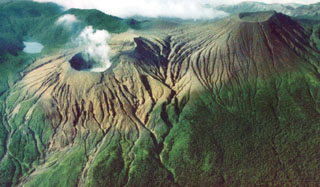Report on Rincon de la Vieja (Costa Rica) — October 2007
Bulletin of the Global Volcanism Network, vol. 32, no. 10 (October 2007)
Managing Editor: Richard Wunderman.
Rincon de la Vieja (Costa Rica) Continued fumarolic activity; sulfur floating in the lake
Please cite this report as:
Global Volcanism Program, 2007. Report on Rincon de la Vieja (Costa Rica) (Wunderman, R., ed.). Bulletin of the Global Volcanism Network, 32:10. Smithsonian Institution. https://doi.org/10.5479/si.GVP.BGVN200710-345020
Rincon de la Vieja
Costa Rica
10.83°N, 85.324°W; summit elev. 1916 m
All times are local (unless otherwise noted)
During September 2006 through at least May 2007, low-level fumarolic and seismic activity continued at Rincón de la Vieja. At the edge of the crater, Fumarolic gases often irritated the eyes, skin, and throat.
During September 2006, the level of the lake was high, with convection cells and particles of sulfur floating on the surface. The lake displayed yellow color with minor evaporation and a temperature of 39°C. Fumarolic activity was occurring in the S wall and SW part of the crater. Columns of gases rose above the edge of the crater and were carried by the predominant winds toward the W and SW. The fumaroles on the N side produced only low-level emissions.
By April and May 2007, the level of the lake had descended some 50 cm with respect to September 2006. The lake color turned to gray with minor evaporation. In the S, there were particles of sulfur floating on the surface and a temperature of 45°C. The fumarolic activity on the SW wall displayed low levels of gas emission and rich sulfur depositions. The fumaroles of the N side were inactive.
Geological Summary. Rincón de la Vieja, the largest volcano in NW Costa Rica, is a remote volcanic complex in the Guanacaste Range. The volcano consists of an elongated, arcuate NW-SE-trending ridge constructed within the 15-km-wide early Pleistocene Guachipelín caldera, whose rim is exposed on the south side. Sometimes known as the "Colossus of Guanacaste," it has an estimated volume of 130 km3 and contains at least nine major eruptive centers. Activity has migrated to the SE, where the youngest-looking craters are located. The twin cone of Santa María volcano, the highest peak of the complex, is located at the eastern end of a smaller, 5-km-wide caldera and has a 500-m-wide crater. A Plinian eruption producing the 0.25 km3 Río Blanca tephra about 3,500 years ago was the last major magmatic eruption. All subsequent eruptions, including numerous historical eruptions possibly dating back to the 16th century, have been from the prominent active crater containing a 500-m-wide acid lake located ENE of Von Seebach crater.
Information Contacts: E. Fernández, E. Duarte, R. Van der Laat, M. Martinez, W. Sáenz, V. Barboza, Observatorio Vulcanologico Sismologica de Costa Rica-Universidad Nacional (OVSICORI-UNA), Apartado 86-3000, Heredia, Costa Rica (URL: http://www.ovsicori.una.ac.cr/).

